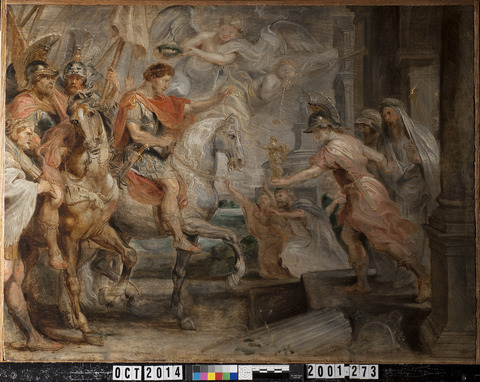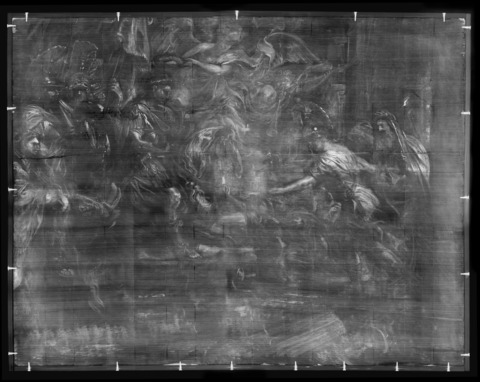Overview
Identification number: 2001.237
Artist: Peter Paul Rubens
Title: The Triumphant Entry of Constantine into Rome
Materials: Oil (untested) on oak panel
Date of creation: About 1621
Previous number/accession number: C10069
Dimensions: 48.7 × 64.5 cm
Conservator/examiner: Fiona Beckett and Roxane Sperber
Examination completed: 2014, revised 2019
Distinguishing Marks
Front:
None
Back:
None
Summary of Treatment History
Physical evidence, including cradling, suggest that several interventions occurred prior to the painting entering the collection of Dr. Clowes. The painting was also treated on several occasions since arriving at the Indianapolis Museum of Art (IMA).
In 1963, Louis Pomerantz applied a wax-resin adhesive to areas of cleavage, filled areas of loss on the left edge with a chalk-PVA mixture (polyvinyl acetate emulsion), and inpainted with “Bocour’s” acrylic paints (n-butyl methacrylate), which were then locally coated with PVA (AYAF in methyl alcohol) and Ruheman’s surface wax.1
Documentation suggests a series of condition assessments and treatments were carried out on the collection around the time the works were moved from the Clowes’s residence to the IMA in 1971. A condition report by Paul Spheeris in October of that year, likely carried out before the paintings were relocated, described the painting as “O.K.” and no treatment was deemed necessary.2 A second condition assessment was carried out upon arrival of the paintings at the IMA. This assessment describes the work as being in good condition and no work was necessary.3
In 2005, the painting was surface cleaned at the IMA by David Miller. The painting was subsequently examined and documented in the Clowes Collection annual survey from 2011 to 2020.
Current Condition Summary
Aesthetically, the painting is in good condition with no obvious discoloration of the varnish or inpainting. Structurally, the painting is in good condition with the panel remaining in plane and no areas of instability in the paint or support.
Methods of Examination, Imaging and Analysis
| Examination/Imaging | Analysis (no sample required) | Analysis (sample required) |
|---|---|---|
| Unaided eye | Dendrochronology | Microchemical analysis |
| Optical microscopy | Wood identification | Fiber ID |
| Incident light | Microchemical analysis | Cross-section sampling |
| Raking light | Thread count analysis | Dispersed pigment sample |
| Reflected/specular light | X-ray fluorescence spectroscopy (XRF) | Fourier-transform infrared spectroscopy (FTIR) |
| Transmitted light | Macro X-ray fluorescence scanning (MA-XRF) | Raman microspectroscopy |
| Ultraviolet-induced visible fluorescence (UV) | ||
| Infrared reflectography (IRR) | Gas chromatography–mass spectrometry (GC-MS) | |
| Infrared transmittography (IRT) | Scanning electron microscope -energy dispersive X-ray spectroscopy (SEM-EDS) | |
| Infrared luminescence | Other: | |
| X-radiography |
Technical Examination
Description of Support
Analyzed Observed
Material (fabric, wood, metal, dendrochronology results, fiber ID information, etc.):
The painting is executed on an oak (Quercus spp.) panel composed of two boards with horizontal grain pattern.4The angle of the ray flecks on the back of the panels indicates the panels are tangentially sawn.5 No dendrochronology was possible due to the attachment of wood fillets to the end grain of the panel. Rubens used oak panels for the majority of his preparatory sketches.6 Other instances of Rubens using tangentially sawn boards has been documented, and he frequently used boards with defects in his supports.7
Characteristics of Construction / Fabrication (cusping, beveled edges of panels, seams, joins, battens):
The join in the boards is difficult to make out in the X-radiograph, possibly due to the density of the cradle crossbar. However, the divergent directions of the ray flecks on the back of the panel, above and below the central horizontal cradle crossbar, make it clear that a join is located in this area (tech. fig. 1).8 Two splits across the entire painting are also visible above the join. A third split is located in the lower-right area of the panel. The panel was likely thinned prior to the application of the wooden cradle on the back, eliminating any indications of original tool marks or beveling.
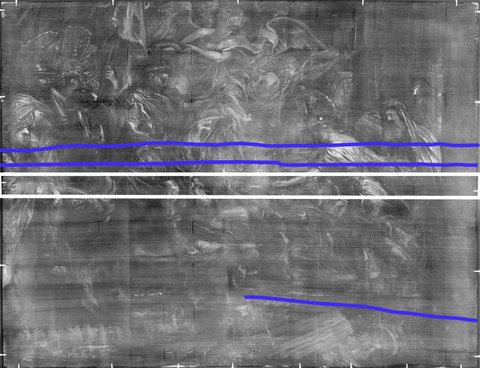
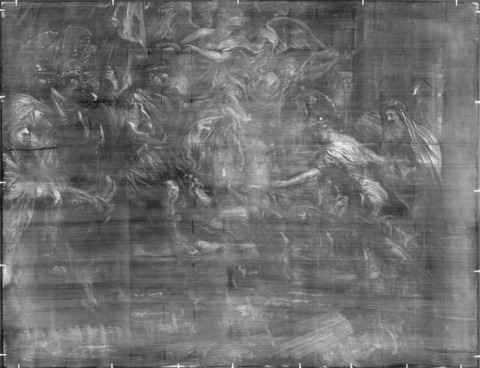
Thickness (for panels or boards):
Approximately 0.6 cm thick (1.9 cm with cradle).
Production/Dealer’s Marks:
No production marks are present as the panel was thinned, and no dealer’s marks are visible.
Auxiliary Support:
Original Not original Not able to discern None
The panel is cradled with a well-crafted twentieth-century cradle with nine fixed horizontal members and seven movable vertical members (tech. fig. 2). All members have seized due to dimensional changes in the wood in response to fluctuations in temperature and relative humidity. The ends of the cradle members are beveled as they meet the outer edge of the support, and all horizontal members have slightly rounded edges. The back of the original panel has been planed down, sanded, and subsequently stained with a wood varnish to more closely match the color of the cradle. All four edges are securely covered with edge strips.
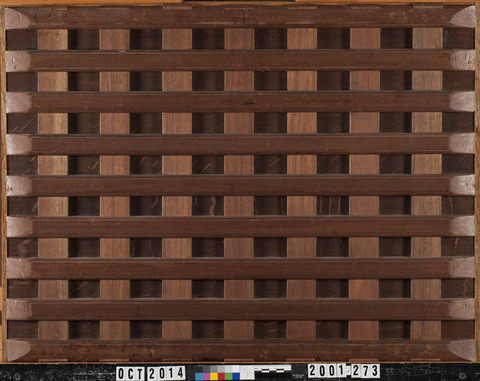
Condition of Support
The panel is currently in stable condition and is relatively in plane. There is a slight convex warp that measures 0.5 cm from the center of the panel to the edge. The panel was also thinned before the addition of the cradle. There are a few splits that have been repaired, likely at the time the cradle was attached. The cradle was likely applied to correct the panel’s warp and as a “preventative” measure. The cradle members have seized, indicating that the cradle has experienced movement due to environmental fluctuations resulting in warping of the support. Slight wear is discernible along edges of the panel as well as light wear on the cradle. The back of the original panel has a few scratch marks where the wood stain has been abraded (this appears to have happened before the addition of the cradle).
Description of Ground
Analyzed Observed
Materials/Binding Medium:
Examination revealed a light-colored ground layer. The ground is likely composed of calcium carbonate with a binder of animal-skin glue. This technique was common in panel preparation techniques north of the Alps. XRF analysis identified calcium throughout the painting, further supporting this assertion.
Color:
The ground is an off-white color. It appears to have yellowed slightly over time. A second layer, consisting of a light gray imprimatura, is also present across the painting (tech. fig. 3). This layer structure is consistent with other painted sketches by Rubens. The artist began using a gray imprimatura after 1610.9 Both the light ground and the gray imprimatura layer are visible to the naked eye.
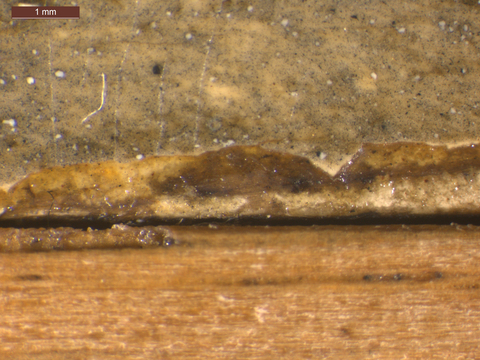
Application:
The imprimatura was applied with a large brush in sweeping strokes (tech. fig. 4). These strokes created diagonal textured brush marks from the upper-left corner to the lower-right corner through the center of the composition. The texture of the imprimatura is particularly visible when imaged with raking light and in the infrared reflectogram (tech. fig. 4). This appears to have been left unsanded, and the paint applied sparingly, allowing the streaking preparatory layers to remain prominent.
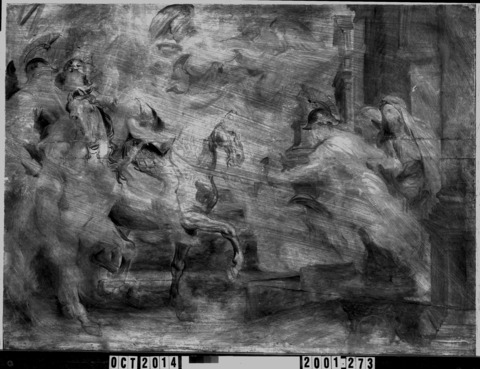
Thickness:
The ground appears to be of medium thickness, with a light gray imprimatura layer applied thinly over top in a way that leaves the white ground exposed in many areas of the painting. Rubens’s distinctive application of the imprimatura is inconsistent with other artists of the period and is so consistent across the artist’s oil sketches that, in Julius Held’s estimation, it should be considered essential to making attributions.10
Sizing:
While not visible or analyzed, as consistent with panel preparation methods of the time, animal-glue size would likely have been applied to the panel prior to the ground layer.
Character and Appearance (Does texture of support remain detectable / prominent?):
Both the texture of the horizontal wood grain and the streaky brush marks from the application of the imprimatura remain visible through the paint layers.
Condition of Ground
The ground appears to be in stable condition and well adhered to the panel. No active delamination is visible. Small losses of the paint and ground are present along the perimeter of the panel where the edge strips are attached. Minor losses of the ground occurred in the areas around the split in the support. This area was inpainted during the 1963 conservation campaign. A slight cracking network, originating in the ground-panel interface, is present and is due to differential movement of the wood and ground layer. This is related to the painting’s natural aging process over time. The cracks remain stable and do not detract from the aesthetics of the composition.
Description of Composition Planning
Methods of Analysis:
Surface observation (unaided or with magnification)
Infrared reflectography (IRR)
X-radiography11
Analysis Parameters:
| X-radiography equipment | GE Inspection Technologies Type: ERESCO 200MFR 3.1, Tube S/N: MIR 201E 58-2812, EN 12543: 1.0mm, Filter: 0.8mm Be + 2mm Al |
|---|---|
| KV: | 25 |
| mA: | 3 |
| Exposure time (s) | 150 |
| Distance from x-ray tube: | 36” |
| IRR equipment and wavelength | Opus Instruments Osiris A1 infrared camera with InGaAs array detector operating at a wavelength of 0.9-1.7µm. |
Medium/Technique:
The painting is a sketch, and part of a series of 13 preparatory sketches for tapestries. The underdrawing was executed in a fluid black medium, likely carbon-containing, as it appears strongly absorbent in the infrared reflectogram. The same black fluid medium appears to be diluted into a lighter gray wash in some areas of the composition. The outlines of the figures and details are more prominent in the infrared reflectogram (tech. fig. 4) and were later slightly obscured by subsequent paint layers. Despite being a sketch, there are also bold, confidently applied lines that do not reveal hesitation or subtle adjustments that would typically be expected in a preparatory work. This suggests another preliminary sketch or composition planning would have occurred prior to this sketch. The series of 13 painted sketches on panel would allow the artist to show a more complete example of what the tapestries would look like to the patrons. The black outlines and details are not only underneath the paint; it appears that Rubens then went back in after painting, applying further details to the composition in a similar medium. This is particularly evident in details of the horse (tech. fig. 5) and areas of the armor.
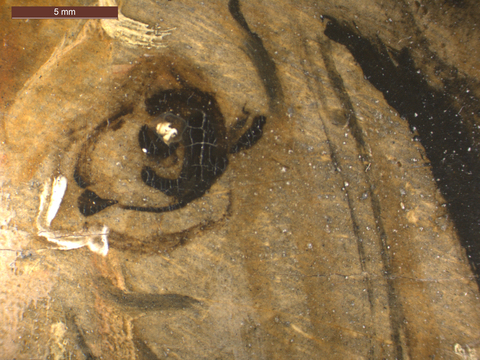
The tapestry woven after the design in the IMA’s sketch is located at the Philadelphia Museum of Art (tech. fig. 6). The composition in the tapestry is very similar to the sketch, though more elaborate and detailed. It was also reversed and reduced in its horizontal dimensions.12 This may be a result of the dimensions of the loom on which the tapestry was woven. The painted sketches would typically have been transferred to full-scale watercolor cartoons on paper, which would then serve as the template for the weavers during the construction of the tapestry.13
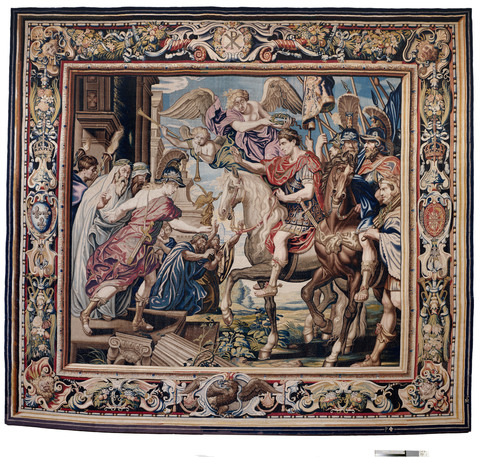
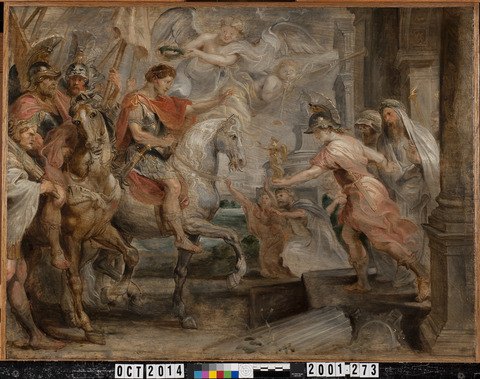
Pentimenti:
No major changes or pentimenti to the composition are discernible. Minor refinements exist between the lighter initially applied underdrawing and the darker details added in the final stages of painting, for example in the horse’s eye (tech. fig. 5).
Description of Paint
Analyzed Observed
Application and Technique:
The paint layer was loosely and fluidly applied. Many of the colors appear to have mixed during the application process, but lines of pure colors can also be seen under the microscope. The paint layer remains quite thin, and the imprimatura and white ground layers are readily visible in much of the painting. The paint has been applied by scumbling in several areas. Both wet-in-wet (tech. fig. 8) and wet-over-dry (tech. fig. 9) techniques are present, suggesting there was some time allotted for drying during the painting process, especially after the application of the gray imprimatura layer. Additionally, the black defining lines such as in the horse’s eye were applied in the final stages of painting and do not appear to have blended with surrounding paint, suggesting a drying time was alotted before the final application of outlining. Highlights were also applied in the later stages of painting and pure lead white as well as lead-tin yellow (as visually observed under the microscope) appear to have been dabbed on areas of the horse mane, armor, and other higlighted areas. Some glazes may have been applied, particularly in the greenish-blue areas, but it is difficult to distinguish between the residues of varnish or abraded areas of glaze. Some of the brown areas appear also to be a glaze. Many areas of the composition remain in a partial state of finish, such as the ruins of columns, the ground, and the transparency of many the figures; however, this is consistent with the purpose of the sketch.
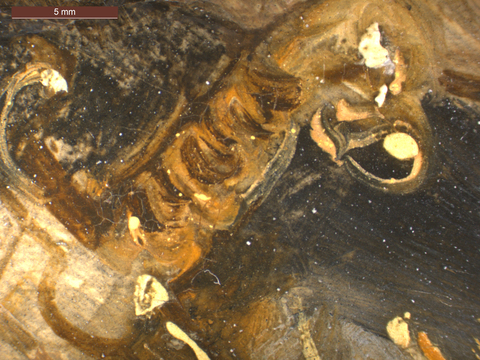
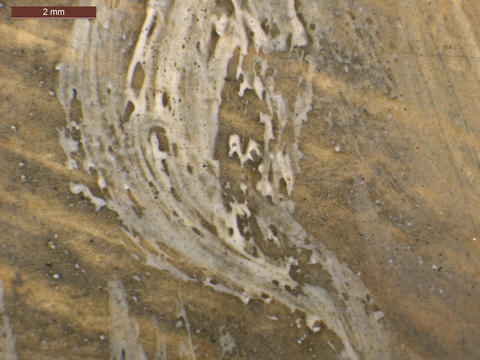
Painting Tools:
Brushes of varying sizes, no evidence of palette knife or other hard-edged tools.
Binding Media:
Appears to be oil.
Color Palette:
A variety of colors are used in this sketch. The overall tone of the painting is brown and gray, enlivened by hints of brighter colors including reds, blues, touches of green, and yellow. XRF analysis was carried out in locations to determine the possible pigments that Rubens used. The analysis indicates that lead white was used throughout the painting, likely included in the light gray imprimatura layer. The presence of mercury and iron indicate that vermilion and iron oxides were used for the reds. Copper was found in the blues indicating the use of azurite, and the presence of lead and tin indicate lead-tin yellow was employed for the yellows. The presence of lead-tin yellow indicates a likely date between 1350 and 1750 (commonly used from the fifteenth to seventeenth centuries), which is consistent with the presumed date the panel was painted. Umber was also used throughout the painting, as indicated by the presence of manganese, and it is likely that carbon black was used (but cannot be identified using XRF). Some of the browns appear very thin, and it is possible they could be glazes. Other pigments that may have been used include organic pigments such as madder, which cannot be identified using XRF.
XRF Analysis:
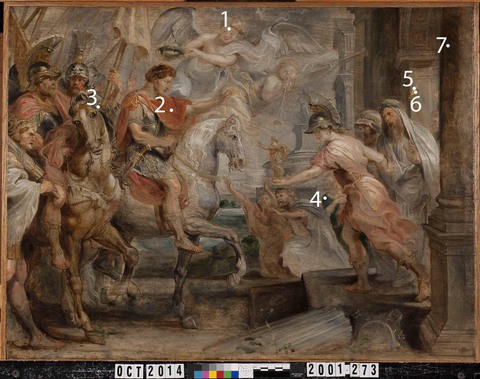
| Sample | Location | Elements | Possible Pigments |
|---|---|---|---|
| 1 | Skin tone, angel’s forehead | Major: Pb Minor: Hg, Fe, Ca Trace: Ti, Mn, Cu, Sn, Si | Lead white, vermilion, iron oxide (earth pigments including umber), calcium (likely from ground), trace of lead-tin yellow, trace of copper-containing green pigment (or azurite).or impurity. |
| 2 | Red cloak, Constantine | Major: Pb, Hg, Fe Minor: Ca Trace: Ti, Mn, Cu, Si | Lead white, vermilion, iron oxide (earth pigments including umber), calcium (likely from ground), trace of copper-containing green pigment (or azurite) or impurity. |
| 3 | Black outline, horse | Major: Pb, Fe, Ca Minor: Hg, Cu, Mn Trace: Si, Mn, Cu, Ti | Lead white, iron oxide (earth pigments including umber), calcium (likely from ground), trace of vermilion, trace of copper-containing green pigment (or azurite) or impurity. |
| 4 | Blue-green mother’s cloak | Major: Cu Minor: Pb, Ca, Fe Trace: Ti, Mn | Copper-containing green pigment (or azurite), lead white, iron oxide (earth pigments including umber), calcium (likely from ground). |
| 5 | Yellow on torch | Major: Pb, Minor: Sn, Ca Trace: Fe, Cu | Lead white, lead-tin yellow, calcium (likely from ground), trace of iron oxide (earth pigments), trace of copper-containing green pigment (or azurite) or impurity. |
| 6 | Red on torch | Major: Hg, Minor: Pb Trace: Fe, Ca | Vermilion, lead white, iron oxide (earth pigments), traces of calcium (likely from ground). |
| 7 | Brown in column | Major: Pb, Ca, Cu, Fe Minor: Mn Trace: Hg, Ti | Lead white, calcium (likely from ground), copper-containing green pigment (or azurite), iron oxide (earth pigments including umber), traces of vermilion. |
Table 1: Results of X-ray fluorescence analysis conducted with a Bruker Artax microfocus XRF with rhodium tube, silicon-drift detector, and polycapillary focusing lens (~100 μm spot).
*Major, minor, trace quantities are based on XRF signal strength not quantitative analysis
Surface Appearance:
The paint was applied in relatively thin passages, with a few areas of impasto located primarily in the highlights. There are some areas of retouching, predominantly along the splits in the wood or abrasions.
Condition of Paint
A micro-cracking pattern from natural aging extends over the entire painting, typical of paintings on panel. Small paint losses are scattered throughout the painting. Some wear is visible around the perimeter of the painting where the paint is in contact with the frame. Some of the paint may have been abraded from a previous cleaning. Lead soaps are present in several areas and can be seen easily under the microscope as protruding white lumps (tech. fig. 11). Some embedded dirt and old, displaced varnish can be observed in the valleys of the more textured areas of the painting (tech. fig. 12). It is difficult to tell, but it is also possible that glazes may have been used, and these areas might contain residues from the abrasion of the glazes. Overall, the paint layer remains structurally sound and is in good aesthetic condition.
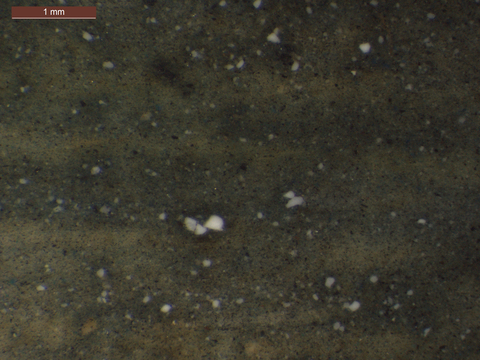
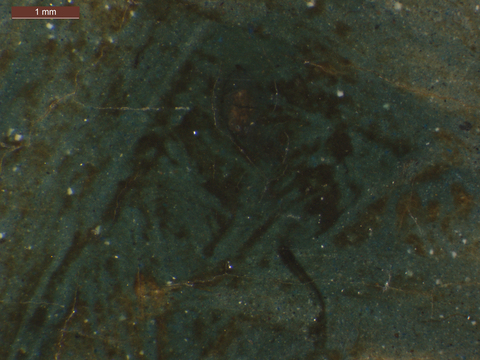
Description of Varnish/Surface Coating
Observed Analyzed Documented
| Type of Varnish | Application |
|---|---|
| Natural resin | Spray applied |
| Synthetic resin/other | Brush applied |
| Multiple Layers observed | Undetermined |
| No coating detected |
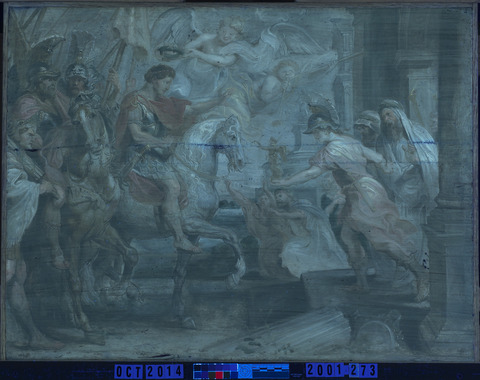
Examination of the painting under ultraviolet-induced visible fluorescence reveals the presence of a thin coating of natural resin varnish over the surface of the painting (tech. fig. 13). Several campaigns of retouching are present from an older restoration, as well as from a more recent inpainting campaign. These appear to be quite minimal and delicately applied to areas of loss, primarily along the splits in the wood.
Condition of Varnish/Surface Coating
Despite the natural resin varnish over the entire surface, the painting does not appear discolored. A few small scuffs and minor losses are visible, particularly around the perimeter where the painting is in contact with the frame, but otherwise the varnish is intact. Surface dirt is present in small amounts throughout the painting. The most recent retouching fluoresces purple under ultraviolet-induced visible fluorescence.
Description of Frame
Original/first frame
Period frame
Authenticity cannot be determined at this time/ further art historical research necessary
Reproduction frame (fabricated in the style of)
Replica frame (copy of an existing period frame)
Modern frame
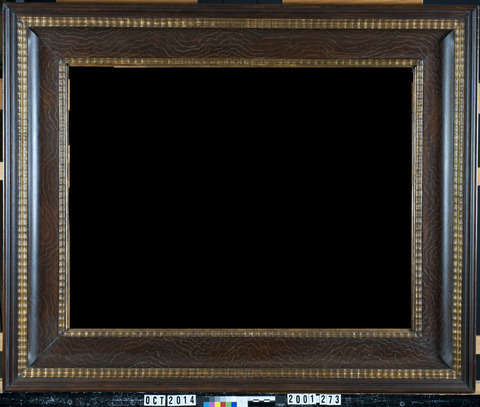
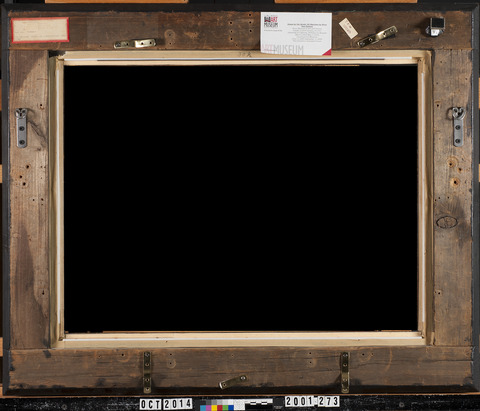
Frame Dimensions:
Outside frame dimensions: 86 × 68 × 4.5 cm
Sight size: 65 cm × 45 cm
Distinguishing Marks:
Item 1. Rectangular white label with a double red border, upper-left, frame back:
“CLOWES FUND INCORPORATED/ FINE ARTS DEPARTMENT/744 SPRING HOLLOW ROAD/ INDIANAPOLIS 8, INDIANA, U.S.A”
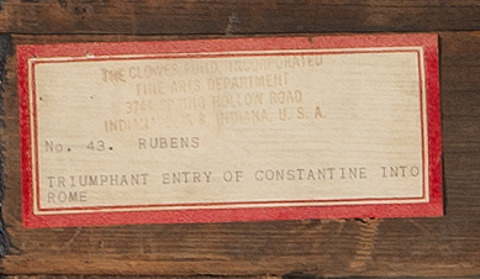
Item 2. Rectangular white label, upper member, central-right, frame back, from the Cincinnati Art Museum.
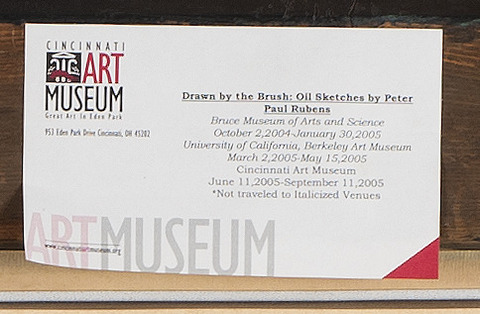
Item 3. Small rectangular label, upper member, central-right, frame back with writing: “TR#10069”.
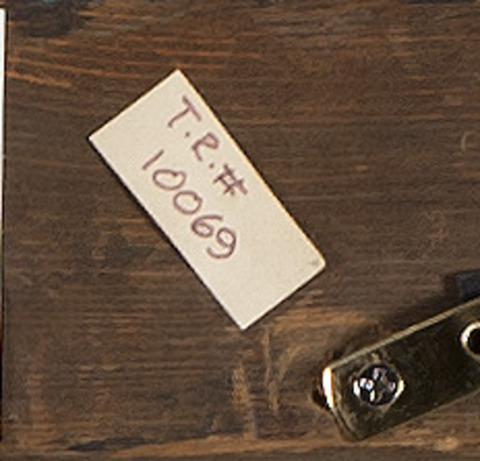
Description of Molding/Profile:
The frame is a simple four-member, mitre-jointed construction. The reverse has been built up, and the corners are butt joints. The wood is stained a dark brown and features prominent rippling wood grain throughout. A gilded, beaded inner edge and one closer to the outer edge are present as the main decorative elements. The frame is not original to the painting and was constructed at a later date.
Condition of Frame
The frame is in stable condition with only minor general wear throughout. Numerous holes and scratches are present on the reverse from the adjustment of the hanging hardware.
Notes
-
Louis Pomerantz, treatment report, C10069 (2001.237), 25 February 1962, Conservation Department Files, Indianapolis Museum of Art at Newfields. ↩︎
-
Paul A.J. Spheeris, “Conservation Report on the Condition of the Clowes Collection,” 25 October 1971, Conservation Department Files, Indianapolis Museum of Art at Newfields. ↩︎
-
Martin Radecki, Clowes Collection condition assessment, undated (after October 1971), Conservation Department Files, Indianapolis Museum of Art at Newfields. ↩︎
-
Ian Tyers, “Tree-Ring Analysis and Wood Identification of Paintings from the Indianapolis Museum of Art: Dendrochronological Consultancy Report 1082,” January 2019, p. 32, Conservation Department files, Indianapolis Museum of Art at Newfields. ↩︎
-
Email correspondence with Ian Tyers, 5 March 2019. ↩︎
-
Joyce Plesters, “Samson and Delilah: Rubens and the Art and Craft of Painting on Panel,” National Gallery Technical Bulletin 7 (1983): 33, http://www.nationalgallery.org.uk/technical-bulletin/plesters1983. ↩︎
-
Pascale Fraiture and Hélène Dubois, “Dendrochronological and Technological Examination of Painting Supports. The Case of Rubens’s Studio Practice” in Tree Rings, Art, Archaeology: Proceedings of an International Conference, Brussels, Royal Institute for Cultural Heritage, 10–12 February 2010, ed. Pascale Fraiture (Brussels: Royal Institute for Cultural Heritage), 316, 323. ↩︎
-
Email correspondence with Ian Tyers, 7 March 2019. ↩︎
-
Julius Held, The Oil Sketches of Peter Paul Rubens: A Critical Catalog (New Jersey: Princeton University Press, 1980), 1:10. See also: Joyce Plesters, “Samson and Delilah: Rubens and the Art and Craft of Painting on Panel,” National Gallery Technical Bulletin 7 (1983): 33, http://www.nationalgallery.org.uk/technical-bulletin/plesters1983. ↩︎
-
Julius Held, The Oil Sketches of Peter Paul Rubens: A Critical Catalog (New Jersey: Princeton University Press, 1980), 1:10. ↩︎
-
Elvacite 2040 (synthetic resin) was used to fill the cradle while shooting the X-radiograph so that the appearance of the cradle would be minimized in the X-radiograph and allow the composition to be better interpreted. ↩︎
-
Tapestry showing Constantine’s Triumphal Entry into Rome from the series known as "The History of Constantine the Great," http://www.philamuseum.org/collections/permanent/57725.html?mulR=12906|37 ↩︎
-
Marjorie E. Wieseman, catalog entry 11 in Drawn by the Brush: Oil Sketches by Peter Paul Rubens, eds. Peter C. Sutton, Marjorie E. Wieseman, Nico van Hout (New Haven and London: Yale University Press, 2004), 128–129. ↩︎
Additional Images


